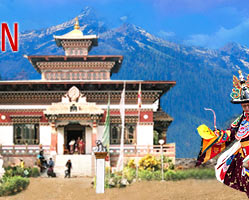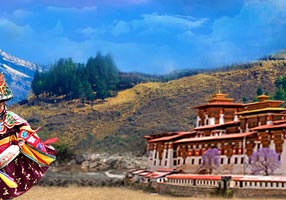Chortens, known as ‘stupas’ in India, are quite common in the countryside of Bhutan. Thousands of chortens can be found all over the country, at crossroads, near a dzong or a monastery and even on high mountain passes. They range from being very small and just two meters in height to being huge and over ten meters in height. Serene and peaceful, chortens are religious monuments that are built in a precise way and are a receptacle for worship or offering. Chortens were originally built to keep the relics of the Buddha and other Buddhist saints but with time, building a stupa is considered a pious thing to do and the builders and those who pay to make a chorten are believed to earn merit for it. Chorten or a stupa is considered to support faith and represent Buddha’s Body.
Chortens or stupas also symbolize the five elements of the Universe. Its square base represents earth, the dome represents water, the shaft represents fire, the crescent represents air and the circle represents ether. One of the five ‘Jina’ (also known as Dhyani Buddhas or primordial Buddhas) corresponds to each of these elements. For religious and didactic reasons, the chorten has always been an object of faith and devotion for the entire Buddhist world. All the major gompas or monasteries have their own chortens, preserving the remains of the Head or Senior Lama. The walls of the chorten are painted from inside with murals, each telling a different story. Sometimes thick prayer walls called ‘mani’ connect chortens. Chortens may be built in various ways. The most common one in Bhutan is called ‘Khangtseg, that’ or house chorten, which is simply a building with a square base, enclosed on all four sides sealing sacred objects and relics inside it and perhaps an ornamental roof.
There is a wooden square known as ‘sokshing’ that acts as the central post of the chorten, around which it is built. It is adorned and has inscriptions of sacred text representing the vital principle and ‘life spirit’ of the chorten. While building a chorten, there are special rituals and ceremonies for each stage of work as it commemorates the death (Parinirvana) of the Buddha Sakyamuni and his spiritual progress towards enlightenment. The other types of chortens are Chendebji or Chorten Kora that follow the model of Bodnath in Nepal, made up of lime washed stone and are huge; smaller Tibetan style chortens; and pure Bhutanese square chortens or stupas with four-sided roofs. The red stripe below the roof called ‘khemar’ mark the religious nature of chortens, just like dzongs.




